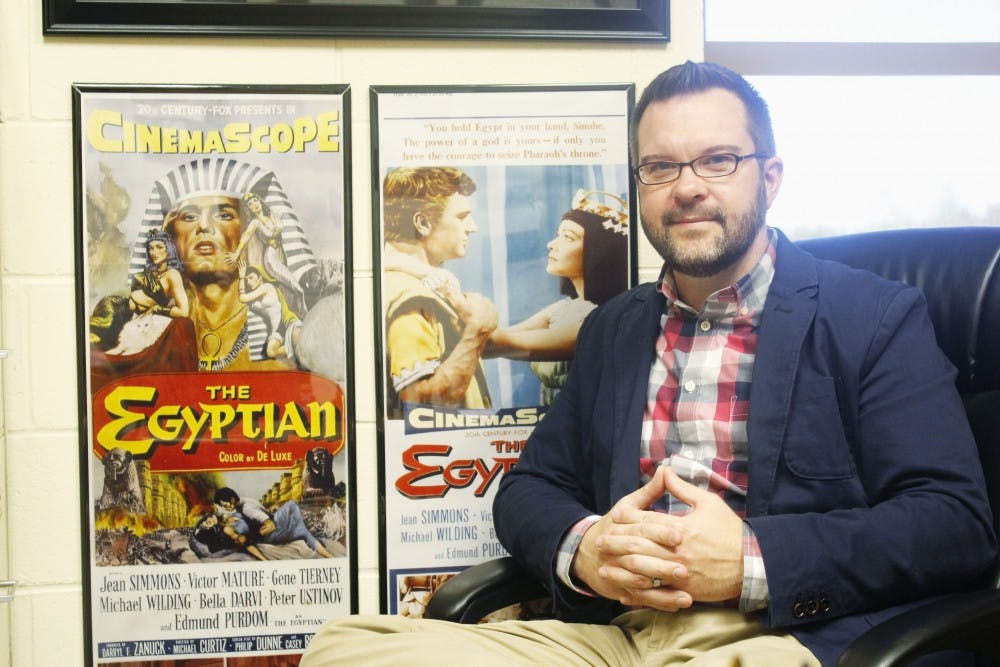By Elyse Baron | Echo
Guards yelling at him in Egyptian and sand filling his shoes with each step, Professor Kevin Johnson raced up an embankment that seemed determined to prevent him from reaching the top. His goal was not to escape authorities with a priceless artifact, but to take a simple photograph. Ten feet away from him, on the other side of a small link chain, was a wall decorated with hieroglyphics that Johnson desperately needed a glimpse of for his dissertation.
The journey to that moment all started his freshman year of college. Johnson, professor of history at Taylor University, stepped onto the campus of Erskine College, anticipating his experience in a class on archaeology. Only offered every four years, Johnson was thrilled to be accepted into the class, even though he had no prerequisites. The friendship he built with his professor during that semester brought Johnson to his love of Egypt and Egyptology.
"I've always felt a connection," Johnson said. "I get the people of ancient Egypt. I see what makes them tick. They are normal people who complain, who argue, who are jealous . . . They're not that difficult to figure out because they are just humans trying to survive in an environment that which, quite frankly, was very good to them for many, many years."
During his junior and senior years at Erskine, Johnson participated in a one-on-one independent study focusing on the reading and interpreting of hieroglyphics. Such a class required complete focus, since the professor always knew when Johnson had given his attention to the assignments. The three-hour class helped prepare Johnson to, when he was pursuing his doctorate at Arizona State University, participate in an archaeological dig in Egypt as the head of inscriptional evidence.
The dig Johnson was involved in was a mortuary temple for the female pharaoh Tausret. Every morning, Johnson and his fellow workers would wake up at 5 a.m. to get dressed and take a boat across the Nile River, then climb into a Jeep and drive across the desert to the site. Each work day lasted from 7 a.m. to 1 p.m. in attempts to avoid the unbearably hot afternoon sun.

Johnson and other graduate students were not the only ones working at the dig. Johnson estimates that around 85 percent of the workers were native-born Egyptians. Living in villages near the mortuary temple, these workers had a direct connection to the dig.
"If we found anything while we were digging it was usually the workmen who found it first," Johnson said. "So they get really excited. Like they will start dancing and singing and clapping when they find something. It's a big deal to them."
Working for such long hours helped create a bond between the American graduate students and the Egyptian workers. Johnson was invited to lunch at one 60-year-old worker's home. While there, Johnson and his friends were required to watch television programs, ride on the homeowner's donkey and look at the pictures of every foreign visitor that had entered the house. Everything the Egyptian man owned was utilized to make the Americans feel more at home. What Johnson had first anticipated to be a simple meal resulted in an all-night event. Lunch was not served until 7 p.m., long after Johnson had thought he would be returning to his rooms across the Nile.
Building those relationships helped Johnson understand more about the culture of Egypt. The local families would take Johnson and the other American graduate students to restaurants to order cheap authentic Egyptian food. The more time the two groups associated, the closer they became. One symbol of the close friendship was the giving of nicknames. The Egyptian workers, many of whom were Muslim, watched the American workers to determine which member of Egyptian and Islamic history a team member reminded them of. Nicknames could be based on personality or appearance. Johnson's own nickname was based on his facial hair: Faris, the name given to a medieval, mustached, Muslim warrior.
Working on the dig at Tausret's mortuary temple helped cement in Johnson's mind that Egyptology is more than learning about mummies. Yes, Johnson and the crew at the site did find a mummified hand, but that was not what Johnson remembers the most. Instead, Johnson values the stories he helped create.
"It's (archaeology) probably not as much fun sometimes as those digs (you see in the movies) because they are finding stuff left and right and you may be digging for days and you're not finding anything, per se," Johnson said. "You're taking down the levels so you can see more of the temple, or at least more of the remains of it. But also, it can be more colorful because you've got cultural elements that kind of come into it."





